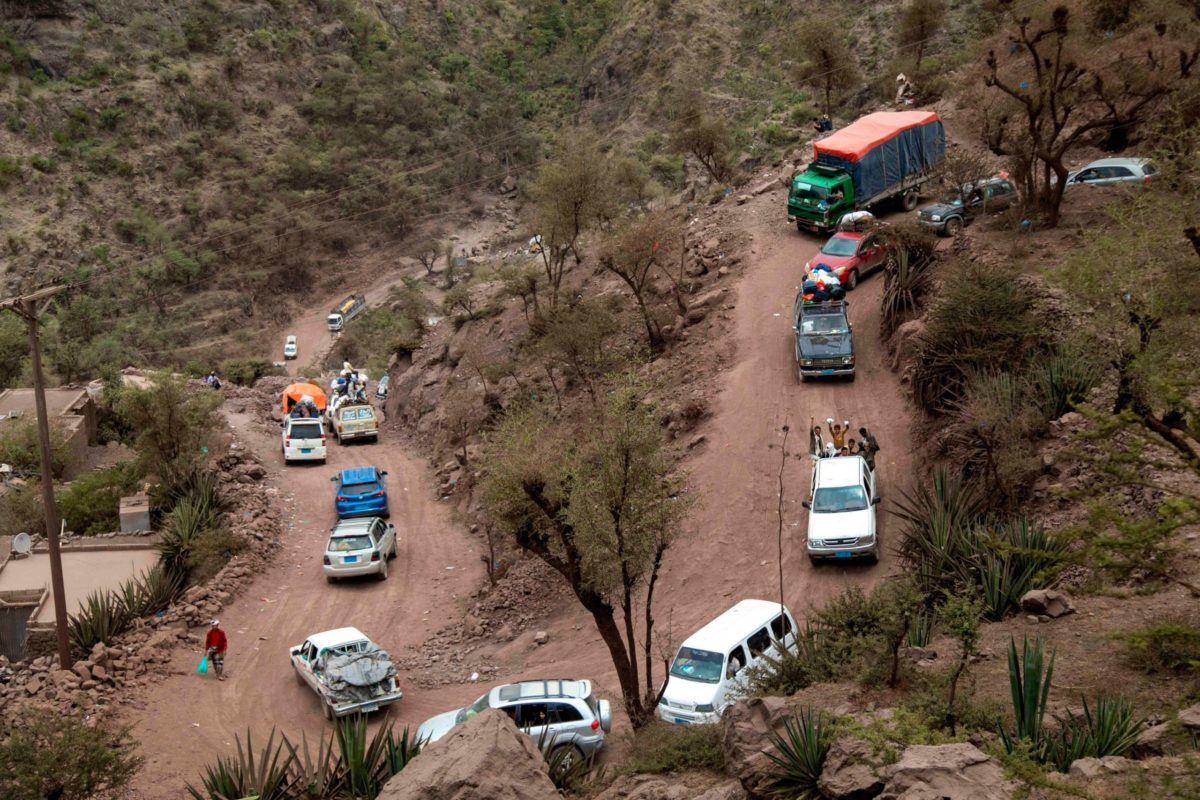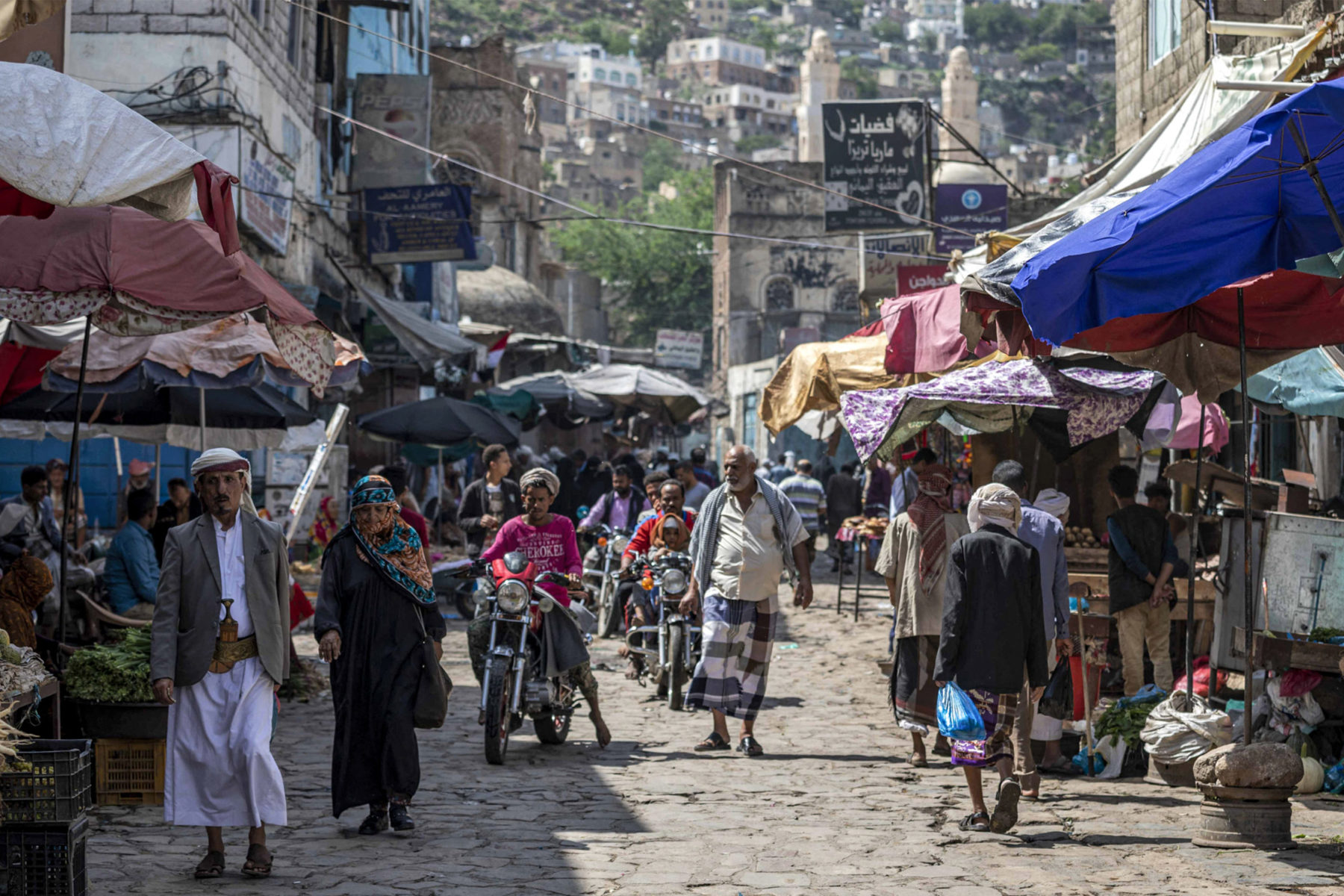
Traffic on a heavily damaged narrow road that serves as a lifeline between Taiz and the southern port of Aden, 2022. Ahmad al-Basha/AFP via Getty Images
Located between the better-known cities of Sana’a and Aden, Taiz has long served as both a geographical and cultural gate to Yemen’s south and particularly Aden. During the years of Yemen’s civil war, the governorate has been a Houthi stronghold. Houthis control the roads leading into and out of the region and effectively controlled the movement of people and essential goods for nearly eight years. Meanwhile, the city itself is bisected by armed checkpoints manned by a range of conflict actors.
Despite the clear centrality of Taiz to the ongoing conflict in Yemen, policymakers have routinely dismissed the view that this city will be key to any military effort to alter the balance of power. The Saudi-led coalition of former president Abd Rabbuh Mansour Hadi and his cabinet, who governed from 2011 until April 2022, paid minimal attention to Taiz. They offered only occasional aid to the city, as it defended the internationally-recognized government’s legitimacy and bore the brunt of the Houthi military campaign.
Taiz—and the fate of its people—has also remained largely peripheral to the peace process. In the UN-led Stockholm Agreement of 2018, the city featured only as an afterthought. The parties agreed to a nominal “statement of understanding” regarding the need for a committee to address the impasse in Taiz. It was not until 2021 that Hans Grundberg, the latest in a string of UN Special Envoys, finally visited Taiz and began to address the siege of the city as a substantive entry point to wider confidence-building measures between the warring parties.
In the truce brokered by the Special Envoy between Houthi forces and the Saudi-backed Coalition in early April of 2022, the easing of restrictions on Sana’a airport and Hodiedah port by the Saudi-led Coalition was conditional on the Houthis opening the roads to Taiz city. The truce, however, is currently in limbo, and the roads have not been reopened for trade or transit.
Today, for the first time in history, the president of the newly-constituted Presidential Leadership Council, the prime minister and the speaker of parliament are all Taizis, yet none of them has prioritized reopening the roads to Taiz in peace negotiations. This impasse leaves the civilian population—itself an engine of Yemeni civil society and an untapped resource for peace—entirely at the mercy of militias in their efforts to access essential services.
Locating Taiz in Yemen’s Past and Present
It was not surprising that Taiz played a central role in the uprising against the regime of former President ‘Ali ‘Abdullah Saleh in 2011. Even before the unification of the two Yemens, Taiz served as the epicenter of civic and political activism in Yemen. It is the most populated governorate in the country with a skilled and educated workforce. Many civil society organizations, trade unions and historical political movements were born in Taiz, and some of Yemen’s most widely-recognized political figures, including important nationalists like Ahmed Mohammed Noman, have longstanding ties to Taiz.
In April 2015, as Houthi forces pressed southward from Taiz toward Aden, previously non-violent protesters against Houthi control in Taiz took up arms. In the eight years since, Taiz has remained the southernmost reach of Houthi power, enforced through brutal violence and remaining under siege.
Surrounded by Houthi control, the city itself serves as a stronghold for the Saudi-supported Islah party, but this party is as much a rival of the UAE-backed Southern Transitional Council as it is an adversary of the Houthis. Meanwhile, Tariq Saleh’s National Resistance Forces—which, like the Southern Transitional Council, enjoy the patronage of the Emiratis—has established a presence along Taiz governorate’s west coast in and around the strategic port city of Mocha. Given the strained relations between Islah and the UAE, it has been difficult for the Coalition-backed government to coordinate any kind of uniform command in Taiz, even as armed groups flock there.
The city’s current predicament is not simply a function of the Houthis’ exploitation. It also reflects the failure of Taiz’s local authorities and of the forces loyal to the Islah party to protect citizens from unruly gunmen and general disorder. Young men like Ghazwan al-Mikhlafi and others—so-called “mufaseen” who disregard the law and wave weapons around to take what they like by threat or use of force—harass and blackmail the local population. Though some initially participated in the fight against the Houthis, efforts by local security forces to rein in their lawlessness have largely failed.
The Many Roads to Taiz
Taiz’s physical location in Yemen has given the city and wider governorate strategic importance in the conflict. Its roads are key battlegrounds in the fight for economic and political supremacy between Houthis forces keen to institutionalize their control and forces at least nominally loyal to the internationally-recognized government who seek to wrest control from them.
During the years-long siege, and particularly while the Sana’a airport was closed from August 2016 to May 2022, this road and the city of Taiz, more generally, has been a lifeline for many northerners, who must transit through the governate to access Aden airport for medical treatment or other essential business.

An open-air market in Taiz, Yemen, 2022. Ahmad al-Basha/AFP via Getty Images
The city of Taiz itself is a commercial hub and a site of Yemen’s most important factories owned by the Hayel Saeed Anam Group—a powerful business conglomerate with factories throughout al-Hawban to the east of Taiz. These factories, which produce everything from basic foodstuffs to cigarettes, are more profitable than the city center and currently represent a significant source of income for the Houthis, who have worked hard to keep this area under their control. They have established an effective blockade that compels residents to travel several hours at high risk along zigzagging roads to reach al-Hawban, rather than the 10 minutes it would ordinarily take by car.
The truce between the Houthis and the government, which was extended twice between April and October 2022, remains at the time of writing neither renewed nor broken, but lapsed. Despite the terms of the truce being conditional on the roads to Taiz opening, neither the government, the Saudi-led coalition nor the UN has been able to secure concessions from the Houthis in Taiz and reopen the roads for any durable period of time. Without any tangible progress toward reopening the roads that connect the city of Taiz to the rest of Yemen, there will be neither peace nor prosperity for millions of people. Depriving the citizens of Taiz—millions of people—of basic mobility prevents them from enjoying the fruits of any temporary peace agreement or ceasefire.
The Road to Peace
Throughout the war, Taizis have repeatedly demonstrated that they are not waiting for a nationwide peace agreement. Rather, they are already doing the work of rebuilding their city on their own terms.
Since the expiration of the UN-brokered truce in October of 2022, Taiz has remained hostage to a negotiation process that overemphasizes the political and military priorities of Aden and Sana’a. But Taiz—on the periphery of each—might hold the key to the peace process, not merely in its present form as a city divided, but also in its future promise as a crucial passage to recovery. Under the right political circumstances, Taiz could transform from an emblem of the horrors of war to an engine of successful demobilization and post-conflict recovery. Indeed, rather than marginalizing Taiz in the peace process, starting the demobilization process in a city like Taiz, which has a demonstrated appetite for a shift away from conflict, is a promising road to conflict recovery.
[Mohammed al-Qadhi is a Yemeni journalist who has reported for several media outlets, including Sky News Arabia TV, Bloomberg News, The Washington Post, The National and France 24. He was based in the city of Taiz from 2015–2019 and currently works as a senior political advisor for the Centre for Humanitarian Dialogue in Geneva.]
Read the previous article in MER issue 305 “Peripheries and Borderlands.”
